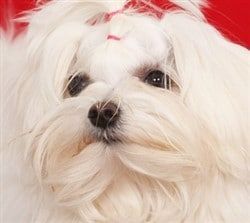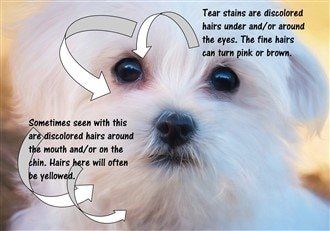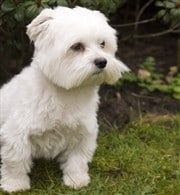How to Keep a Maltese As White as Snow
Overview
If you have a Maltese puppy or dog, keeping the coat white may be one of your top concerns and rightfully so.
While this breed can be found with light tan or lemon coloring on the ears, a pure white coat is this breed’s most famous trait.
In fact, making sure that your Maltese’s coat stays white can put an owner under pressure in a seemingly never ending effort to keep it free from discoloration. This is because a Maltese's coat is a blank canvas, and everything in a puppy or dog's world will affect it; like tiny pinpoints of paint on a canvas.
This said, it is relatively easy to keep a Maltese exceptionally white, if you have the right products and keep to a schedule of coat care tasks.
In this section, we will go over:
- How the white coat came to be (it was not always so)
- Exactly how to keep all areas of your Maltese pure white
Please note:
PetMaltese is reader-supported. Some of the product suggestions on this page are affiliate links. As an Amazon Associate we earn from qualifying purchases. This is at no extra cost to you and helps us continue creating useful content.
Eager to skip right to coat care?
Jump to Elements that Discolor a Coat and How to Keep it White.
The History of the White Coated Maltese
Ancient writings from both Athens and Rome speak of small white dogs, thought to be the Maltese. And interestingly, most poems and stories believed to reference the ancient Maltese breed also talk of a white coat. However, we know that color did exist in the bloodline long ago and over the centuries the most obvious change to the breed was a focus on breeding it down in size and not its color.
Documents show that in the 17th and 18th centuries, the size of the Maltese was essentially pared down by 50%. This was done by cross breeding him with other small breeds; theorized to be the toy Poodle and perhaps the miniature Spaniel.
So what could have influenced breeders to change direction and focus on a white coat? Perhaps due to the white coat being mentioned in the works of famous poets such as Martial of Rome or the writings of Abbé Jean Quintin d'Autu,developing a pure white dog became a goal among those who established kennels to perfect the breed.
After all, it would certainly set the Maltese apart from so many other tiny toy dogs. And this did indeed start to happen; at least to some degree.
-min-450x321-1920w.jpg)
Bella, photo courtesy of Silvia McNeil
Up until the early to mid-1900’s there were other full-coat colors, including tan and beige. So, when did the Maltese start to only have a white coat? This happened by the mid to late 1900’s. Multi-colored Maltese stopped being accepted in England show rings in 1913 and the last record of a conformation show that held a Maltese other than white was in Australia in 1950.
Since then, a pure white coat has been the universal trademark of this breed.
Today, pure white coats are the color standard
all over the world, including the AKC, CKC, KC and FCI; And even though some beige and lemon may be found on the ears, it is not desirable in the show ring.
Responsible breeders will only pair together pure white dogs, since this is what is expected with the Maltese: a white coat of silky, straight, single coated hair.
Once that puppy finds its way into a loving home, it will be up to the owners to keep the coat white. There are many factors that can discolor the hairs. We will talk about all of the things you can do to keep a Maltese puppy or dog’s coat as white as can be.
Elements that Discolor a Coat and How to Keep it White
There is not one single
grooming task that will keep a Maltese dog’s coat white. It is a combination of grooming techniques, care, and using the right products that will all come together over time to keep the coat free from tinges of discoloration.
For this reason, an owner must be dedicated to the coat. If you simply let a Maltese ‘be’, the coat would be cream at best and full of stains in the worst case scenario.
There are 5 main elements that all work together to keep the coat free of discoloration:
1. Keeping the face white
2. Wiping the body
3. Brushing
4. Shampoo and coat products to enhance white
5. Environmental elements
Let's dive into the details of each of these.
#1 Keeping the Face White
If you asked what was the single element that kept a Maltese from looking white, we’d have to say that it is discolored hairs on the face. The coat can be as white as a fresh snowflake but if there is red or brown staining around the eyes or dripping down onto the cheeks, this robs one of the noticing the otherwise white coat on the body.
Another issue is yellow hairs on the chin and around the mouth; these will immediately deny a Maltese of what would otherwise be snow white coloring.
When you look at a dog, you focus on his face, much like you do when you interact with humans. And while we will certainly go over steps to keep the entire coat white, we simply must begin with the face and tear staining issues.
Sadly, many owners either think that colored hairs around the eyes are ‘normal’ or they give up on this area and simply accept it.
The problem is that this is not just an aesthetic issue; red, brown or otherwise tear stained hairs are often crusty, can interfere with the dog’s sight and can become clumped sections of dirty bacteria.
When hairs are red, this can point to a growth of red yeast bacteria. And this is not something that you want so close to your dog’s eyes.
Many elements of grooming and care to keep the coat white will also aide in keeping the facial hairs white and tear stains away; however when a Maltese already has established tear stains it is very important to clear them up with the right product.
Once they are diminished, you can then continue on with steps to keep the entire dog white which will also include the eye area.
You will want to:
1) Use a daily wipe
(recommendations ahead). This will take care of saline tears, eye discharge, bits of food, and other elements that affect the face. Wipe your Maltese's entire face, from the forehead down over the chin and around each eye, 2 to 3 times per day. After each meal is best.
Note that once you go to step #2 and remove stains, still continue to use the wipes every single day. If not, stains will reappear.
2) Use a tear stain remover.
One of the most well-known products is Angel Eyes. It’s been around for a long time and perhaps due to marketing or the catchy name, it’s the one that many owners rely on. It is a decent product. However, it is not our recommended choice.
When it comes to keeping a Maltese white, this is no time to be half in the game. Use the most effective product possible that can produce quick results, so that you can clear up the problems and focus on the coat as a whole.
You'll find that Eye Envy
 works very well with the Maltese breed and SPA by TropiClean
works very well with the Maltese breed and SPA by TropiClean
 is a great choice as well.
is a great choice as well.
Now that you know how to keep the face clean and white, let’s look at the many other things that will work in conjunction with this.
#2 Daily Wiping to Keep the Coat White
Baths and brushing are very important, and we will get to those in a moment; however, do not discount the importance of daily body wiping.
White coats are constant magnets for all sorts of particles. Bits of grass, minute leakage from colored fabrics, sprinkles of urine, bits of feces, tiny sprays of sand or dirt, and an assortment of other environmental elements will cling to the coat and combine to hide its true white color.
Therefore, use a quality canine body wipe like Earthbath's All Natural Grooming Wipes
 each day. This is done as so:
each day. This is done as so:
1) Go over the head, down the neck, over the chest, and down the forelegs 2)
Go over the back and flanks, swoop over the tail, and go down the hind legs 3)
Finally, go over the underbelly, genital area and the behind to pick up small splatters of urine and any tiny pieces of feces.
#3 The Importance of Brushing to Keep the Coat White
Overview:
Brushing a Maltese, with a coat of any length, is about much more than keeping the coat free of tangles and distributing body oils. It is part of what needs to be done to keep the coat pure white via removal of fine particles of dust, dirt, and debris buildup.
Wipes (as mentioned earlier) are important; however, brushing needs to be done as well, to separate the hairs and loosen debris that has fallen to the roots. Separated hairs are cleaner hairs, so brushing & combing the coat should on a regular basis.
Frequency:
If your Maltese has a short puppy cut, brush every 3 days. If your Maltese has a moderate hair cut, brush every other day. And if your Maltese has a long show coat, brush every day.
Technique:
For all but shaved coats, this should be comb, brush, comb, with a spritzing done as you go.
This is done as follows, working in sections:
1.
Comb to separate the hairs to ensure that there are no tangles. * See below for mats.
2.
Brush to remove debris.
3.
Spritz as you go with a leave-in conditioner that will protect the hair shafts and essentially create a shield.
Spray the leave-in about 1 inch from the roots, making long strokes with the brush to distribute it down to the tips. You do not need to load the coat making it heavy (and too much product will block healthy air circulation). Just a light mist will do the trick.
It is recommended to do this in the morning, since with a nighttime application some of the product may rub off when a Maltese sleeps. However due to what may be a busy schedule, it may need to be done in the afternoon or evening when owners come home from work.
As long as it is done on a regular basis, it is one step in keeping the coat healthy, clean, and white.
Mats:
If you find a tangle, try your best to work it out by hand, with your hands covered with your chosen leave-in product. If you cannot remove it, use a properly sized de- matting comb to help you work it out.
Types of brushed and combs:
It is recommended to use a 16 mm pin brush for Maltese puppies, a 20 mm pin brush for adults, and a steel two-level comb that is sized for small toy breeds.
Exact recommendations for brushes (puppy and adult), a properly sized two-level comb, and a great little de-matting comb are below.
If you do not see the images, try a refresh. On mobile, you may need to turn your phone horizontal to see all 4 items.
#4 Shampoo to Enhance White
Every 3 weeks when you give your Maltese a bath, you have a wonderful opportunity to really boost the white in his coat. Do not waste this chance.
Absolutely avoid any shampoo with bleach, this can cause terrible damage to the skin and ruin the coat. However, a secret to keeping Maltese dogs looking like snow is to use quality canine shampoos that have natural white enhancing ingredients like mineral optical brighteners.
Be sure to follow up with a really good conditioner. It will not
affect the wonderful benefits of the whitening shampoo and is needed to keep the coat super silky.
Exact recommendations our top 3 picks for a white enhancing shampoos and a super luscious conditioner are below; if you do not see the images, try a refresh. On mobile, you may need to turn your phone horizontal to see all 4 items.
#5 Controlling Exposure to Environment Elements
It's possible for all white Maltese to remain snow white for life; discoloration can be prevented and removed
The Sun
Sunlight will not discolor a Maltese dog’s coat. It can, however, cause the skin to develop black spots. When there is such a thin, single coat of hair, the skin color under the coat will have an effect on how white the coat is going to look.
Any dark spots will be the base color foundation of the white hairs and will cause them to look darker than they actually are and not appear as white as they otherwise would against white or pink skin.
Some Maltese will very slowly develop darker skin or even some black spotting over the course of any given year with just 30 to 60 minutes of daily sun exposure.
So what can you do if your Maltese's skin is darkening? There are 3 things that can help:
1) Use a quality leave-in conditioner that contains a safe sunscreen.
One like Chris Christensen Ice on Ice Leave-in Conditioner with Sunscreen
 will help stop the sun from affecting a Maltese's skin color and will serve as a shield against all of the various elements that can cover up pure white.
will help stop the sun from affecting a Maltese's skin color and will serve as a shield against all of the various elements that can cover up pure white.
We have already gone over the importance of every 1, 2 or 3 day brushing with a good leave-in product. But, if it is time to head out for a walk and you feel that some of the product has rubbed off, do a light mist over the coat, using a steel comb or pin brush to distribute it.
2) On days with bright sun, if you will have your Maltese out for more than 1 hour, apply a canine sunscreen on your Maltese' belly and any areas with thin hair. The belly and flanks receive reflected sunlight from ground surfaces. A canine sunscreen will protect the body from the penetrating UV rays of the sun.
If you are looking for a good canine sunscreen, you may want to consider Epi-Pet's Sun Protector Spray for Pets ; it is the only FDA approved sunscreen for canines and has an SPF of 35 to 45.
; it is the only FDA approved sunscreen for canines and has an SPF of 35 to 45.
3)
Don’t think of the sun as the enemy. Taking a walk on a nice sunny day is a treat that all owners should be able to enjoy and
daily exercise is important for a Maltese puppy or dog's health. Never avoid it.
However, it can be helpful, if you did not apply a leave-in product, to choose a route that is shaded. Breaks for a rest and a drink of water under the shade of a tree is great.
We do NOT advocate keeping your Maltese isolated in the home just to avoid the sun. That would be a terrible life for a dog and certainly cause him frustration and strip away his opportunities to socialize and explore. If your Maltese's skin reacts to the sun, it takes less than a minute to spritz the coat.
Water
Water may seem like the purest ingredient in the world. After all, what is in water other than water? And how can water have anything to do with keeping a Maltese dog’s coat white? The answer may make you want to never touch the tap again.
In the US (and we assume in many other countries) tap water can LEGALLY contain very nasty things.
The following – in trace amounts – is allowed to be in the city and town drinking water in the United States: Arsenic, asbestos, barium and beryllium ( both of these are discharge from metal refineries), cadmium (this comes from corrosion of galvanized pipes), chromium (runoff from steel mills and known to cause allergic dermatitis ), copper (from corroded household piping systems), cyanide (from plastic and fertilizer companies), lead, mercury, nitrate (leakage from sewage) and selenium (known to cause hair loss).
In addition, Chromium-6 has been found in 51 counties in the U.S., affecting over 200 million people; this is a known carcinogen (the one the Erin Brockovich movie focused on).
If that doesn’t make you want to run out and buy a filter, we don’t know what would.
Needless to say that having your Maltese drink tap water day in and day out, over the course of weeks, months and years can affect his health. Copper and lead are the two most troubling elements that may cause dulling and discoloration, making a coat less white over time.
Though when you think about the health consequences tap water can have, a pure white coat does not seem as important.
Ultimately, we highly recommend obtaining a quality filter for your kitchen tap, using a filtered water pitcher like the Aquagear Water Filter Pitcher
 (this removes 2000% more chemicals than Brita including the cancer-causing chromium-6), or only offering bottled spring water.
(this removes 2000% more chemicals than Brita including the cancer-causing chromium-6), or only offering bottled spring water.
Summary and Round-up
This may have seemed like a lot of steps, but that is because we offered all of the details in case you wanted to know the whys and hows. In summary, you can keep your Maltese super white with:
- Daily wiping of the face with a quality canine facial wipe
- Using tear stain remover if needed
- Daily wiping of the body
- Brushing every 1, 2, or 3 days with a leave-in conditioner
- Giving baths using a whiten-enhancing shampoo
- Being aware that the sun can cause a darkening of the skin, and that a leave-in coat spritz and/or sunscreen will help prevent that
- And giving your Maltese filtered water via gallons of spring water, or a water filtering device.

Effective tips and guidelines that will greatly reduce the stress that a Maltese feels when home alone.

-min-450x169-1920w.jpg)




-min-500x281-1920w.jpg)
-min-330x185-1920w.jpg)
-min-489x321-1920w.jpg)
-min-330x217-1920w.jpg)


-min-180x187-1920w.jpg)

